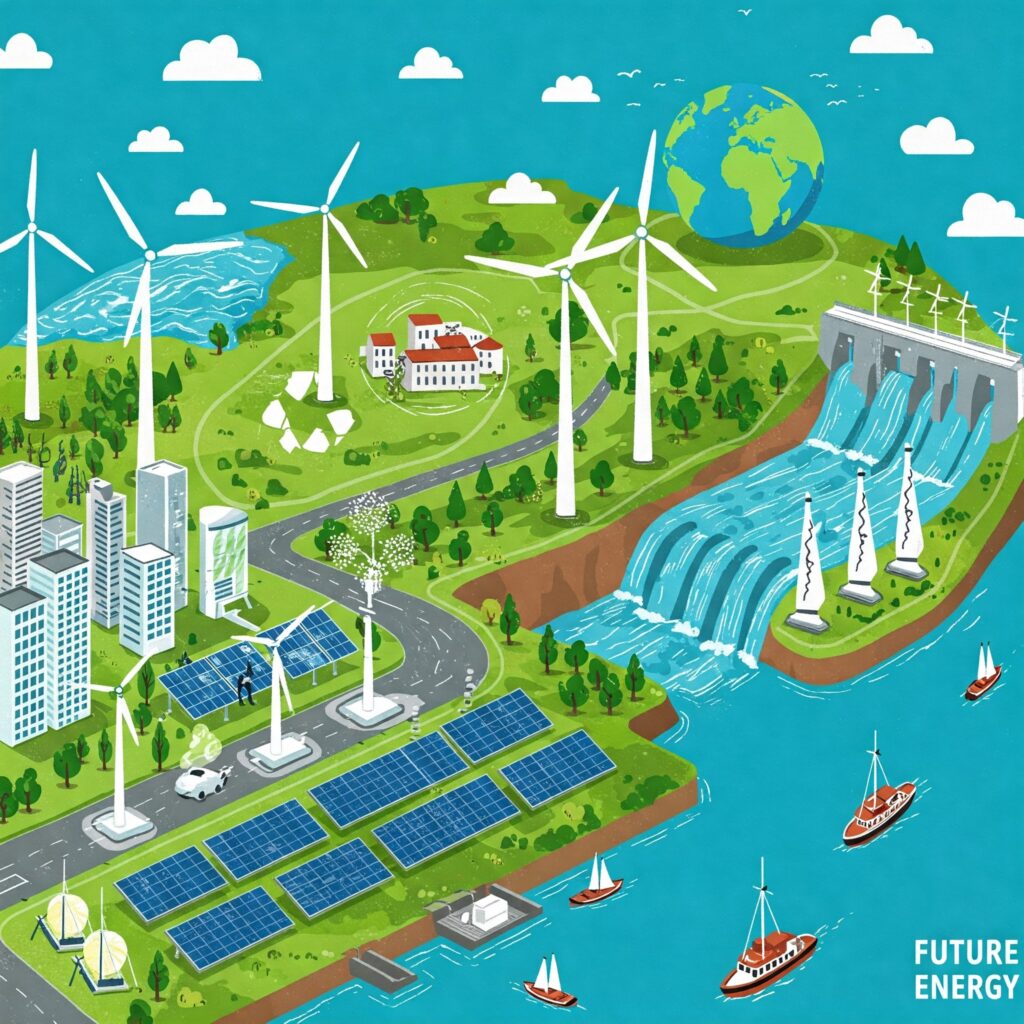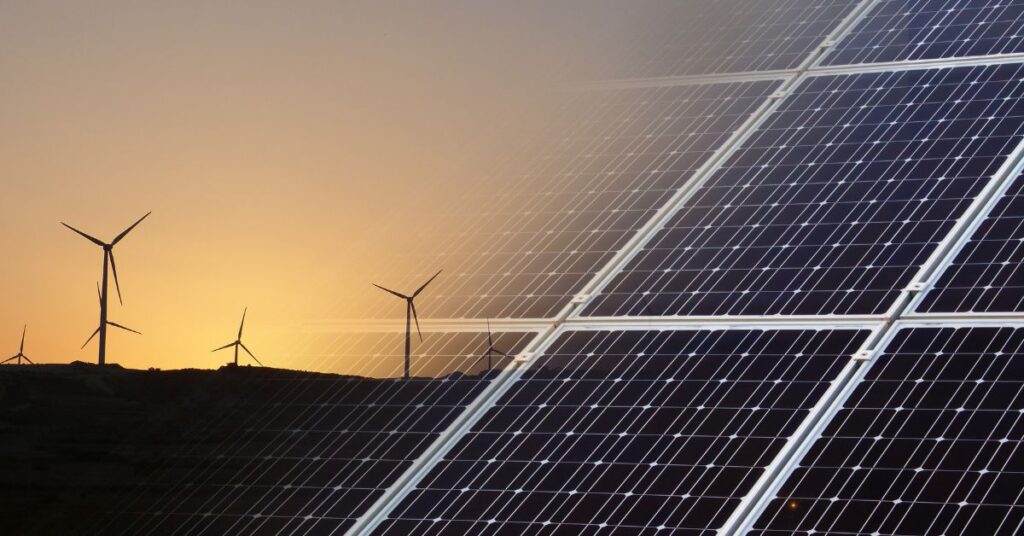Future of Energy Trends- The impacts Donald Trump made on US energy policy during his presidency will remain visible in the long term since his changes have already permeated deeply into this domain. His policy supports deregulation combined with energy independence and continued use of traditional fossil fuels, which reshaped domestic and worldwide energy patterns. However, with a much larger picture, as really said and done, this legacy will turn out to be another critical component shaping the energy landscape of the future against the background of increasing concerns regarding climate change, growing renewable energy markets, and a changing global marketplace in energy itself.

trump’s Energy Policy: Reliance on Fossil Fuels and Deregulation
Donald Trump came into office promising to use his administration’s whole machinery to achieve, among other things, “energy dominance” by ending all federal regulations and ramping up domestic oil, natural gas, and coal production. During the time of President Trump’s administration the sector received deregulation policies that involved reversing most environmental policy tools developed under President Obama’s administration, including the Clean Power Plan, together with methane emission regulations.


Energy from fossil fuels was a major area of focus in Trump’s energy agenda, particularly around fracking, intended to ensure that America remained a net exporter of energy. The US withdrawal from the Paris Climate Agreement made in 2017 was part of keeping the nation apart from a global climate action effort. Thus, by building strong foundations between the oil, gas, and coal industries, Trump-inspired America to become a frontrunner in energy production, as evidenced by soaring oil and natural gas output across the country during his administration.
The administration further developed pipes such as the Keystone XL, which is intended to carry oil from Canada to the United States. The Trump administration pushed forward this strategic initiative in order to emphasize North American energy security along with increasing job opportunities yet the approval steps encountered extensive environmental opposition.
Renewables and the Future of Green Technology
Ultimately, the future of energy trends is really tilted towards renewable energy, notwithstanding the fact that the Trump administration would prefer fossil fuels. Factors that have spurred such growth include global concerns about climate change, technological advancements, and shifting consumer preferences—all of which promise to become effective proponents of green energy.


The incoming Biden administration is believed to take a keen interest in climate policies as part of its agenda—a promise that the US will transform into a clean energy economy for every activity. Biden’s “Build Back Better” platform incorporated lofty objectives for investments in renewable technologies such as solar, wind, and electric vehicles (EVs) while at the same time establishing measures to reduce carbon emissions and encourage clean energy innovation. Therefore, Trump’s efforts to impede the shift away from renewable energy will likely face considerable resistance from federal, state, and private sector efforts to move in a greener direction.
Trump’s fossil fuel policies are likely to shape the energy future in the coming years, especially in Republican-controlled states where fossil fuel industries are vital. The US largely comprises a diversified energy market that includes renewable, nuclear, and fossil fuel sources.
Trump’s Influence on Energy Independence and Geopolitics
The formulation of Trump’s energy policy gained a stronger focus from the goal of achieving energy independence. The presidential administration developed measures to stabilize energy market prices while using domestic oil and gas production to make the United States less dependent on foreign energy sources. For the first time in 75 years, the United States, under Trump’s presidency, exceeded its oil and gas consumption and reached the status of being a net exporter of energy resources.


Being self-reliant in energy caused substantial effects for global political positions. Through foreign policy actions, Trump demonstrated how America could use its energy resources as a strategic tool against OPEC member countries and additional nations supplying oil to the market. The US could impact global oil markets even as it withdrew from international climate agreements and increased its local oil production.
However, with increased global attention to climate change, future of energy trends independence will increasingly begin correlating its value with clean energy production rather than fossil fuels. The very definition of energy independence will likely transform into clean technologies, wind, solar, and battery storage, as renewable source generators worldwide make this transition.
The Private Sector and Technology-Driven Innovation
The government can set the tone with regulations and incentives, but most future of energy trends and progress will come from the private sector. While private companies contributed to the processing of US energy during Trump’s presidential term, particularly oil and natural gas, they are also increasingly developing investments in clean technologies to meet the future demand for renewable energy and succumb to consumer pressure.
Moving forward, technological advancement seems promising as a significant driver of the future of energy trends. In fact, sunlight and wind have become so much cheaper than before that they could now be competitive with even traditional resources like development in energy storage, electric vehicle technologies, and intelligent grid schemes, which represent new receiving areas of the energy industry.
The private sector needs to take the lead in shaping energy’s future by developing research and development into more efficient and sustainable energy technologies. Although the Trump administration has been rock-solid against renewable energy, burgeoning green technologies may be viewed as a continuing shift that will be permanent, regardless of which party leads the government.
The Political Divide and the Energy Debate
US energy has been politically controversial and will continue to be so. This is most stark in how Trump has set the stage for his energy policies in favor of fossil fuels and deregulation while Democrats seek to transition to a clean energy economy, usually framed in terms of environmental justice and climate action. As it gathers strength, the division focuses precisely on how economic growth, job creation, and environmental concerns mesh and is indeed seen as one of the leading questions in energy debates.


While states like Texas, North Dakota, or Alaska, which derive most of their monetary resources from producing fossil fuels, would continue to rely on traditional sources of energy, states like California, New York, and Washington would be leading the way in advancing renewable energy policies. State and private-sector innovations work as amplifiers to boost federal policies when discussing energy matters.
The presidency of Donald Trump brought significant developments to American energy policy through its important historical phase. The Trump administration focused on fossil fuel exploration, deregulation, and energy self-sufficiency, which together created conditions for national energy production growth while reshaping international energy markets. The future of energy trends within the US, however, will probably disfavour anything that falls on fossil fuels and will instead lean toward renewable resources as the world faces bigger challenges on climate change and higher demands for clean energy.
While Trump focused much of his energy legacy on fossil fuels, it is clear that an inevitable movement toward renewable energy technology solutions around the world can no longer be avoided. Ultimately, this continues to forge the future of energy for the coming decades alongside political leadership at the state and federal levels with the full input of private innovation. The full implications of Trump’s energy policies will continue to unfold as the US travels toward a cleaner, more sustainable energy future.
Donald Trump, the Future of Energy, and International Diplomatic Relations
Yet another aspect of energy policy was Trump’s influence beyond domestic considerations because he had far-reaching impacts on the global energy ecosystem and the direction of international diplomatic relations regarding energy. Under Trump, the US went from being a net importer of energy to being a net exporter for the first time in almost 75 years. Such a dynamic brought American energy monopoly reforms across the country, and the geopolitical fractures reshaped these markets further by reflecting worrisome political alliances that would define the future of these international actors. Among other things, his position on fossil fuels, energy independence, and climate change largely determined the future relationships of the US with some major oil-producing countries, such as the EU and emerging economies in the global south.
Energy Independence and Geopolitical Realignment
One of his core energy goals was making the US energy independent, which he sought through increased production of local oil and natural gas and reduced foreign oil imports. Under his office, the United States became a net energy exporter for the first time in nearly 75 years. This transformed major geopolitical considerations by reducing dependence on historically significant exporting countries like Saudi Arabia, Venezuela, and Russia.


This basically meant no more oil imports from the Middle East and Trump’s energy dominance. It is likely to change the United States’ historical alliances on energy trade and security pacts long through the Persian Gulf states. Energy independence gave the US new leverage on the international stage, but at the same time, it transformed energy security relations.
This is just an example of Trump’s energy policy decisions weighing on such issues as withdrawal from the Iran nuclear agreement in 2018 and putting up a “maximum pressure” campaign against Iran. It denoted a broader purpose of checking the influence of countries viewed as opposed to furthering US interests. “I want to flood the market with American oil, pushing Iran out,” he said. Ironically, American sanctions on Iran-bound oil exports caused dramatic changes in the energy landscape, raising oil prices and changing trade flows.
Inversely, strengthening US energy power also meant that countries like Russia became more likely to embrace the United States closer. With the massive growth in shale oil production in the United States, Russia’s status as a leading energy exporter came under greater contention. But oil and gas remained installed, and the interconnectedness of the global energy market was still there. Russia will exert its “influence” through control over European pipelines and as a key player in OPEC+ agreements. Complicated diplomatic dynamics would ensue because, despite being a rival, Russia’s role in energy markets was still indispensable.
Trump’s administration acted all cool with OPEC, which had a strained relationship in areas like cuts in oil production. More so, although the US gained all-booming energy independence, global oil prices would still be determined by actions taken by OPEC and its closest allies like Russia—all made possible through the OPEC+ group.
His accusations against OPEC were, he claimed, propagation on the part of OPEC on global oil prices and called for higher production levels. In 2018, calling for a lowered oil price by OPEC, he argued that his country supplies energy to the world while aggrandizing this point through public comments that highlight a much broader shift in the US approach to energy diplomacy: one where traditional energy-packing powers like OPEC have less influence because of user behavior. Thus, the community of countries in OPEC, such as the United States, would be the beneficiary of this partnership with Saudi Arabia, which had been a very close ally of the US for a long time. The event was a direct rip, grounded in several OPEC+ meetings where US interests were sometimes at odds with those of oil-exporting countries.
Nonetheless, one should not forget that no matter how fierce Trump’s criticisms were, OPEC remained a power to reckon with in global energy markets. Since there is U.S.C. oil importation, decisions orchestrated by OPEC still reign in global oil prices, hence the need for the US to engage diplomatic ties with OPEC for a steady trade in global energy.
Trump’s Takeaway from the Paris Climate Agreement: A Global Position on Climate Diplomacy
During his presidency, Trump triggered a major diplomatic shift when he officially extracted the United States from participating in the Paris Climate Agreement in 2017. Under his larger energy independence goals, Trump directed a policy that put US economic interests ahead of international climate change agreements. According to Trump, the Paris Climate Agreement would impose excessive economic burdens on the US, mainly through its effects on coal production and manufacturing, alongside giving China and India operational advantages that excluded them from obligations.
The withdrawal from the Paris Agreement became a dog ear in the increasingly harsh pages of US history with respect to global climate diplomacy. The greenhouse gas withdrawal activated heavy opposition between European partners and environmental organizations who challenged the policy against rising international pressure for quick climate change solutions. European political leaders, including Emmanuel Macron of France and Angela Merkel of Germany, joined voices with other supporters of the Paris Agreement against Donald Trump’s decision to withdraw from the climate change agreement.
Some of the Trump administration’s actions triggered diplomatic responses from countries abroad while at the same time encouraging countries to implement climate actions independent of US influence. Countries like China, the EU, and India continued to prioritize their commitments to the Paris Agreement and, in many cases, enhanced their efforts toward accelerating the transition to renewable energy.
Apparently, the Trump administration’s withdrawal from the Paris Agreement awoke some US states and cities to action. Aggressive climate policies were adopted by states such as California, New York, and Washington, indicating that energy diplomacy and climate change were not solely in the realm of federal leadership; these topics were also viable platforms for subnational actors.
Energy Diplomacy for the Future
The future of energy trends and diplomacy in the US will depend on how the entire world navigates the intersection of energy security and climate change. As Trump’s fossil fuel push and deregulation might influence US energy policy, new leadership and the dynamic context of renewable energy technology will potentially offer entirely new scenarios for energy diplomacy on the world stage.
Through its return to the Paris Agreement and its clean energy policy, the United States established a leadership position in global climate change combat. The shift in the US position will produce major international implications because countries, together with worldwide corporations, will want to work with America on developing renewable energy and carbon reduction strategies alongside climate support projects. The market for clean energy technologies and critical minerals used in battery storage and green financial institutions will experience escalating competition because of rising energy demands from emerging countries, particularly China, India, and Brazil. The energy market and its diplomatic relations will be transformed by increasing roles of transnational organizations such as the International Energy Agency (IEA) and bilateral energy agreements.
Conclusion: Energy as a Diplomatic Lever
The energy policies established by Donald Trump reformed both American domestic energy management and global foreign relations between countries. The US changed its global energy market role when Trump launched initiatives for domestic energy independence while pulling out from the Paris Agreement and targeting OPEC and other international organizations. Ambassadors will still need to consider energy matters in their foreign policy decisions while their governments follow the global transition toward eco-friendly innovations. Energy will persist as a core component of US foreign policy that affects its diplomatic relations with both nations that export traditional fossil fuels and newer economic powers. The future of energy trends in the world is focused on how the big countries are dealing with it along the line with other nations. Global transitions toward renewable energy, together with growing energy resource importance and climate change concerns, will force governments to adopt different diplomatic approaches. International energy diplomacy inspires worldwide focus because the United States needs to lead the development of sustainable cooperative energy systems between economic growth, environmental sustainability, and energy security objectives.
#BleedGreen


The writer believes awareness is the solution for change. Her comprehension in the field of ecology and environmental studies is impactful. With her knowledge, she had written much content for academic websites and well-known publishing platforms. Here, at BleedGreen, she urges us to share her wisdom of words to bring cognizant in the society for our green resources.




